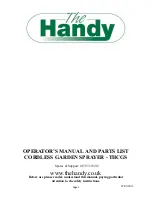
Even the containers considered empty contain chemical residues.
Some publications show that somewhere around 0.3% of the chemicals remains in the
container after being used.
Therefore, discarding the containers without washing out the residues is extremely dan-
gerous to man, animals and environment.
In the case of metal, plastic and glass chemical containers, each container must be rinsed
three times to ensure the residues are completely removed.
This manual describeds how to make the TRIPLE WASH in a correct, safe and effective
way
.
-During the TRIPLE WASH, you must use appropriate protective clothing, such as: gloves, apron,
boots, goggles and protective masks with appropriate filters.
- IMMEDIATELY AFTER emptying the container, you must keep it with
the opening upside down over the sprayer tank opening or over the
bucket that you are using to prepare the chemical mixture for at least
30 seconds, until no residue is left in the container, when the drops are
falling in long intervals
.
- Next, hold the container in the upright position and fill it
with water up to 1/4. For example: in a 20-liter container,
put 5 liters of water.
- Fit the container cap and tight it enough to avoid leakage
during the agitation.
- Agitate the container strongly in all ways (horizontal and
vertical), during approximately 30 seconds to remove the
residues that are sticked to the container internal walls.
06
11
15- TROUBLESHOOTING
- Put about 2 liters of water in the tank.
- While operating the lever, look into the tank to see how the problem arises.
- Refer to the table and diagram below.
RG:452284
2
1
Chamber
Chamber
valve
(diaphragm-3)
Piston cup
Cylinder valve
(diaphragm)
TRIPLE WASH OF EMPTY AGROCHEMICALS CONTAINERS
CORRECTIONS
Worn or dried out piston cup.
Replace or lubricate
the piston cup.
Leakage through the cylinder
upper part (1).
After pumping and pressurizing
the chamber, as you operate the
lever it drops fast.
Cylinder valve (2) not sea-
ling properly due to wear or
impurities.
Clean or replace the
valve.
After pumping and pressurizing
the chamber, the lever rises
slowly when released.
Chamber valve (3) not sea-
ling properly due to wear or
impurities.
Clean or replace the
valve.
PROBLEM
CAUSES
It is necessary great effort to
act the lever and the spray
stops rapidly.
Air leakage through the nut
that fastens the hose to the
chamber.
Drain all the liquid
from the chamber.
Tighten the nut.


























